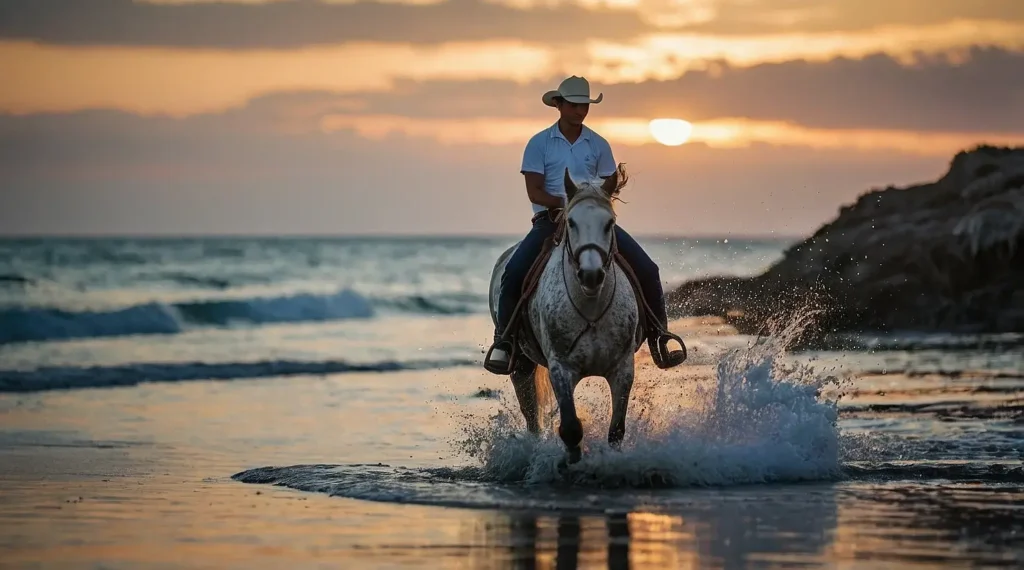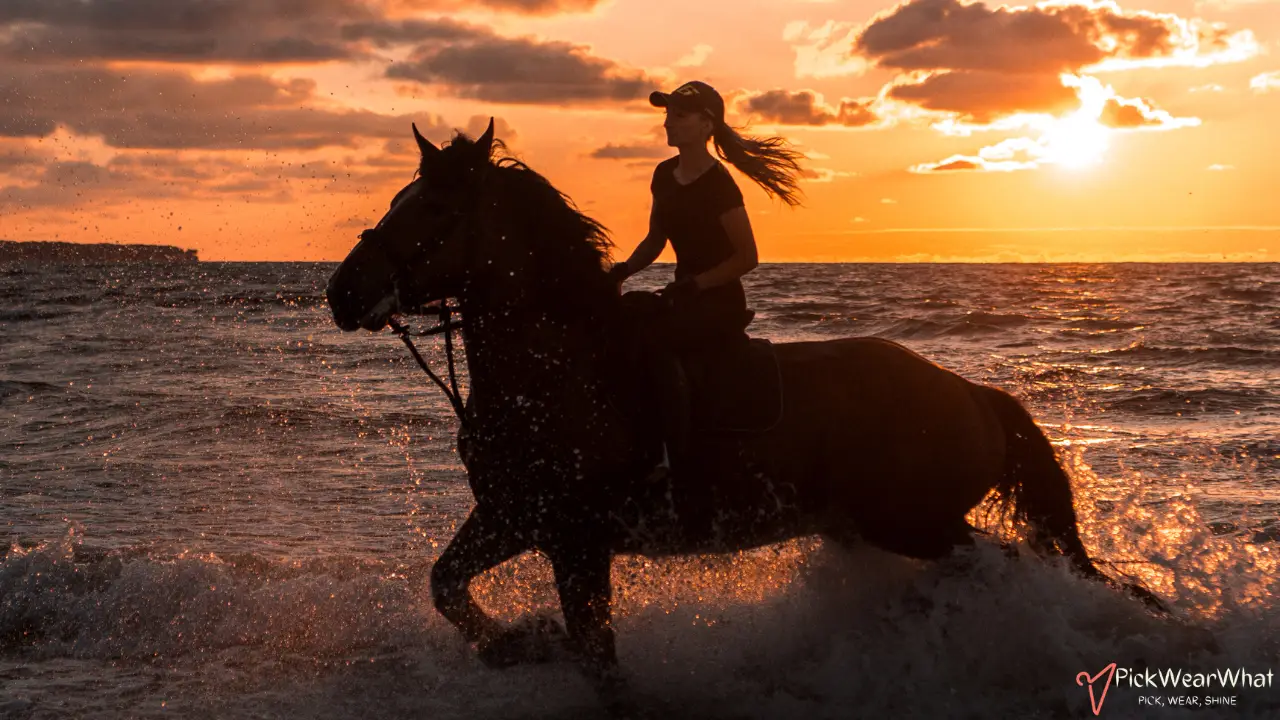When horseback riding on the beach, wear comfortable, breathable clothing such as fitted athletic wear or riding pants paired with a moisture-wicking top. Choose sturdy, closed-toe footwear like riding boots or sneakers to ensure safety and grip. Additionally, bring a hat and apply sunscreen for sun protection, and consider wearing gloves for better control of the reins. Proper attire not only enhances your comfort but also ensures a safe and enjoyable horseback riding experience by the shore.
Why Proper Attire Matters for Beach Horseback Riding?
Wearing appropriate clothing isn’t just about looking the part; it’s about safety, comfort, and functionality. The beach environment introduces elements like sand, water, wind, and intense sunlight, all of which can impact your riding experience. The right attire can protect you from sunburn, chafing, and potential injuries, allowing you to focus on the joy of the ride.
Essential Beach Horseback Riding Attire for Women
Essential Beach Horseback Riding attire for women includes lightweight, breathable clothing such as moisture-wicking shorts or leggings paired with a fitted tank top or breathable shirt. Opt for sturdy, closed-toe riding boots or sandals with a secure strap to protect your feet and provide stability. A well-fitted helmet is crucial for safety, and don’t forget to apply sunscreen and wear sunglasses to protect against the sun.
Additionally, consider layering with a light jacket or cover-up for changing weather conditions and bringing gloves to enhance grip and protect your hands. By choosing the right attire, you ensure comfort, safety, and an enjoyable horseback riding experience on the beach.

Wear Comfortable and Protective Tops
Opt for breathable, moisture-wicking tops that offer protection against the sun. A long-sleeved shirt made from lightweight, quick-drying fabric not only keeps you cool but also shields your skin from harmful UV rays.
When selecting a top, consider materials like polyester blends or specialized riding shirts designed for active wear. These fabrics are engineered to draw sweat away from your body, keeping you dry and comfortable.
Choose a top that fits well without being too tight or restrictive. A collared shirt can provide extra neck protection from the sun, and some riders prefer tops with mesh panels for added ventilation.
Choose the Right Riding Pants or Leggings
Select riding pants or leggings that offer comfort, flexibility, and protection. Long pants prevent your legs from rubbing against the saddle, reducing the risk of chafing and saddle sores.
Riding Breeches vs. Leggings
Riding breeches are specifically designed for equestrian activities, featuring reinforced patches on the inner knee and seat for durability. Leggings made for athletic activities can also be suitable if they are thick enough to provide protection.
Darker colors can hide dirt and stains better than lighter shades. Look for pants made from stretchable materials that allow for a full range of motion.
Footwear: Riding Boots or Closed-Toe Shoes
Wear sturdy riding boots or closed-toe shoes with a defined heel. Proper footwear is crucial for maintaining control and ensuring your safety while riding.
Types of Suitable Footwear
- Paddock Boots: Short boots that are comfortable and provide good ankle support.
- Tall Riding Boots: Offer additional leg protection and are ideal for more serious riders.
- Alternative Options: If riding boots aren’t available, hiking boots with a small heel can suffice.
Footwear to Avoid
Avoid sneakers or any footwear without a heel, as they can slip through the stirrups, increasing the risk of injury.
Head Protection: Helmets Are a Must
Always wear a certified riding helmet to protect your head from potential injuries. Even the most experienced riders can have accidents, and helmets are the first line of defense.
Features to Look For in a Helmet
- Proper Fit: The helmet should sit level on your head and not move when you shake your head.
- Ventilation: Helmets with vents can keep you cooler during hot beach rides.
- Certification: Ensure the helmet meets safety standards set by organizations like ASTM or SEI.
Accessories: Sunglasses and Gloves
Consider wearing sunglasses and gloves to enhance comfort and functionality.
Polarized sunglasses can reduce glare from the sun reflecting off the water and sand, protecting your eyes and improving visibility.
Gloves provide a better grip on the reins, prevent blisters, and protect your hands from sun exposure. Look for gloves made from breathable materials with reinforced grips.
Hair Management: Keep It Secure
Tie your hair back to prevent it from obstructing your vision or becoming tangled. Use a low ponytail, braid, or bun, and secure it with non-metal hair ties.
Essential Beach Horseback Riding Attire for Men
Essential beach horseback riding attire for men includes comfortable, breathable clothing such as moisture-wicking shorts or lightweight pants and a fitted t-shirt or polo shirt. Opt for sturdy riding boots or closed-toe shoes with a secure fit to ensure safety and stability while riding. Wearing a helmet is highly recommended for protection, along with sunglasses and a wide-brimmed hat to shield against the sun.

Opt for Breathable Shirts
Choose lightweight, breathable shirts that offer sun protection. A long-sleeved button-down shirt made from moisture-wicking fabric can keep you cool and shield your skin from UV rays.
Fabrics like cotton blends or specialized athletic materials can provide both comfort and functionality. Look for shirts labeled with UPF (Ultraviolet Protection Factor) ratings for added sun defense.
Consider shirts with vents or mesh panels for increased airflow. A collar can provide additional neck protection from the sun.
Wear Comfortable Riding Pants
Select durable, comfortable riding pants that allow for a full range of motion. Long pants protect your legs from saddle friction and environmental elements.
Types of Riding Pants
- Jodhpurs: Traditional riding pants that offer comfort and style.
- Jeans: If designed for riding, with reinforced seams and no inside leg seams to prevent chafing.
- Athletic Pants: If they are durable and not too loose.
Ensure the pants are neither too tight nor too loose. They should allow you to mount and dismount comfortably and move freely while riding.
Appropriate Footwear: Riding Boots or Sturdy Shoes
Wear riding boots or sturdy closed-toe shoes with a heel of about 1 inch. This helps keep your feet secure in the stirrups.
Footwear Options
- Western Boots: Provide a traditional look and functional heel.
- English Paddock Boots: Short boots suitable for various riding styles.
- Work Boots: If they have a heel and are not too heavy.
Make sure the boots are broken in to avoid blisters and discomfort during the ride.
Safety Helmets Are Essential
Always wear a helmet that meets safety standards to protect your head. Helmets are non-negotiable for safe riding practices.
- Fit: Should be snug but not tight, with adjustable straps.
- Style: Choose between traditional riding helmets or more modern designs, as long as they are certified.
- Maintenance: Regularly inspect your helmet for damage and replace it after any significant impact.
Accessories: Sunglasses and Gloves
Enhance your riding experience with practical accessories like sunglasses and gloves.
Sunglasses protect your eyes from sun glare and wind. Wrap-around styles can offer additional protection from sand and debris.
Riding gloves improve your grip on the reins, especially if your hands get sweaty. They also protect against blisters and sunburn.
Headwear Under the Helmet
Consider wearing a bandana or headband under your helmet to absorb sweat. This can enhance comfort and keep sweat from running into your eyes.
Additional Tips for Beach Horseback Riding Attire
When gearing up for beach horseback riding, choosing the right attire is crucial for both comfort and safety. Keep these additional tips in mind to enhance your experience and ensure you’re well-prepared for the ride.
Layer Your Clothing
Layering allows you to adapt to changing weather conditions. Mornings may be cooler, and temperatures can rise quickly, especially near the water.
- Light Jackets or Vests: Easy to remove and store if you get warm.
- Moisture-Wicking Base Layers: Keep you dry by pulling sweat away from your skin.
Choose Appropriate Colors
Wear light-colored clothing to reflect sunlight and stay cooler. Whites, beiges, and pastels are excellent choices for sunny beach rides.
Avoid Loose or Flapping Clothing
Loose clothing can startle your horse or get caught in equipment. Ensure all clothing is snug and secure.
- Tuck in Shirt Tails: Prevents them from flapping.
- Avoid Scarves: Unless securely tucked in or avoided altogether.
Protect Your Skin with Sunscreen
Apply a broad-spectrum sunscreen with at least SPF 30 to all exposed skin. Reapply as necessary, especially if you sweat or the ride is lengthy.
- Ears and Neck: Often overlooked but susceptible to sunburn.
- Hands and Wrists: If not wearing gloves or if sleeves ride up.
Hydration is Key
Stay hydrated by drinking water before and after your ride. Consider bringing a small, secure water bottle if the ride is long.
Bug Protection
Apply insect repellent if necessary. Beaches can have mosquitoes or other biting insects, especially in the early morning or evening.
What Not to Wear When Horseback Riding on the Beach?
Knowing what not to wear is just as important as choosing the right attire for beach horseback riding. Avoid these items to stay comfortable and safe during your ride.
Avoid Open-Toed Shoes
Do not wear sandals, flip-flops, or any open-toed footwear. They offer no protection and increase the risk of injury.
Say No to Excessive Jewelry
Avoid wearing necklaces, bracelets, or dangling earrings. They can get caught in equipment or distract you during the ride.
Skip the Heavy Backpacks
Do not carry heavy or bulky backpacks. They can throw off your balance and strain your back.
Alternative Options
- Waist Packs: Securely hold essentials without hindering movement.
- Saddle Bags: If provided by the riding facility.
Avoid Strong Perfumes or Fragrances
Strong scents can attract insects or bother the horse. Stick to unscented personal care products.
Do Not Wear Headphones
Avoid listening to music or wearing earbuds while riding. You need to be fully aware of your surroundings for safety.
How to Dress for Different Weather Conditions?
Dressing appropriately for varying weather conditions is key to staying comfortable and prepared. Here’s how to tailor your outfit to suit any weather scenario.
Riding in Hot Weather
Prioritize lightweight, breathable fabrics and stay hydrated. Wear ventilated helmets and consider moisture-wicking base layers.
Riding in Cooler Weather
Layer up with thermal undergarments and a windproof outer layer. Gloves and thicker socks can keep extremities warm.
Preparing for Rain
Wear waterproof gear and consider a raincoat designed for riding. Ensure your footwear is water-resistant.
FAQs About Beach Horseback Riding Attire
Yes, you can wear a swimsuit under your riding attire if you plan to swim afterward. However, ensure it doesn’t cause discomfort while riding.
No, it’s unsafe to ride without proper footwear. Always wear closed-toe shoes with a heel to prevent your foot from slipping through the stirrup.
Yes, if they are comfortable and allow free movement. Jeans designed for riding are preferable due to reinforced seams and appropriate fit.
Bringing a change of clothes is a good idea if you plan to stay at the beach afterward. Riding can make you sweaty or you might get sandy.




